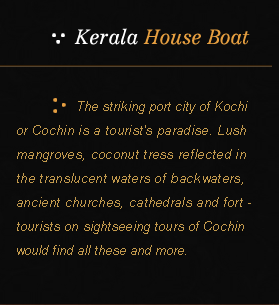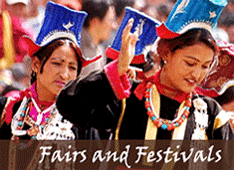
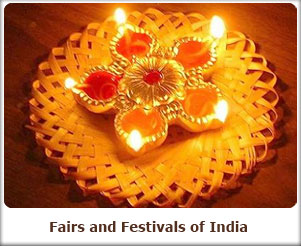 Colorful and lively, THE FAIRS AND FESTIVALS OF INDIA are major attractions of the country. Indian festivals speak of India's rich cultural and traditional background.
Colorful and lively, THE FAIRS AND FESTIVALS OF INDIA are major attractions of the country. Indian festivals speak of India's rich cultural and traditional background.
|
The festivals play an important part in promoting the traditional handicrafts and tourism of India. Reflecting the vibrant culture of the country, these events occupy a prime place in the Indian tourism industry, as many people visit the country in order to participate in them. The rich cultural heritage of India attracts the Western world during the celebration of important festivals. Every region celebrates their festival according to their regional customs and rituals. The commonness in all the celebration is that it celebrates humanity. Some of the common rituals, which are followed in most of the festivals, are processions in the streets, decoration of homes and sacred places such as temples and traditional and folk song and dance performances. Most religious festivals have elaborate prayers, traditions, customs and rituals attached to them. The elaborate celebration and the multitude of festivals in India, each with their own unique legends and significances often awe the foreigners who come to visit India.
The fairs and festivals either celebrate the change of seasons or are of a religious nature. For instance, Mewar Festival and Holi are celebrated to mark the coming of the spring season. Teej of Rajasthan marks the onset of the monsoon. On the other hand, Onam in Kerala and Bihu in Assam are celebrated to mark the harvesting season. Other festivals, like the konark Dance Festival, promote the culture of India. Religious festivals are innumerable over here. Durga Puja, Ganesh Chaturthi, Janmastami, Christmas, Eid-ul-Fitr, Rath Yatra, Vasant Panchami, Ram Nabami and others are some of the popular religious festivals of India. Apart from these, the other festivals that are celebrated include Desert Festival, Elephant Festival, Raksha Bandhan, Nouroz, Diwali and Dusssehra amongst others.
A large number of fairs are also held in India from time to time. People from far and wide come to take part in these fairs. In fact, many tourists plan their vacations according to the time of occurrence of these fairs. Pushkar Fair, Urs Ajmer Fair and Surajkund Crafts Fair are some of the famous fairs of India. The Kumbh Mela and the colorful and grand Goa Carnival are extremely popular among the locals as well as the tourists.
The culture of India is aptly reflected through its numerous festivals and fairs. The colorful festivals are an integral part of every Indians. Bringing out the true spirit of the Indian people and their society, the Indian festivals find their roots in the traditions, religious beliefs, myths and the seasons of the country.
JANUARY
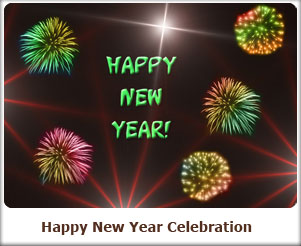 1. New Year Day: New Year symbolizes the rejuvenation time, coming year brings with it new dreams to be accomplished, goals to be achieved and wishes to be fulfilled. People around the globe celebrate New Year with lots of joy and excitement all around. Everyone bids farewell to the current passing year and welcomes the arriving New Year. It is an occasion when rejoicing bids farewell to the passing year with a grand welcome to the New Year.
1. New Year Day: New Year symbolizes the rejuvenation time, coming year brings with it new dreams to be accomplished, goals to be achieved and wishes to be fulfilled. People around the globe celebrate New Year with lots of joy and excitement all around. Everyone bids farewell to the current passing year and welcomes the arriving New Year. It is an occasion when rejoicing bids farewell to the passing year with a grand welcome to the New Year.
Celebrations for the occasion start from 31st December eve only and blast to the zenith at the stroke of 12 midnight. People enjoy together with family and friends, having great time together in relishing lip-smacking food or dancing to the beats.
The New Year comes with many traditions associated with it. Different regions of the world follow different practices on the day. The most commonly followed practices are adopting New Year’s resolution, exchanging gifts, lighting crackers at midnight and of course to wish luck and happiness to everyone by three magical words “ HAPPY NEW YEAR!”
3. Id-ul-Zuha (Bakr-Id) - All over India: Also called Bakrid, Id-ul-Zuha, is a festival of great rejoice. Special prayers and exchange of greetings and gifts marked the Id-ul-Zuha (Bakrid), the festival of sacrifice, celebrated with traditional fervour and gaiety in India.
Id-ul-Zuha is a reminder of Prophet Ibrahim's readiness to sacrifice his son for God's sake. It also marks the completion of Haj (pilgrimage to Mecca). On this day, special `Dua' is recited by thousands of Muslims for peace and prosperity. The day also coincides with the day when the holy Quran was declared complete.
4. Bikaner Camel Festival - Bikaner, Rajasthan: The festival starts with a vibrant procession of beautifully decorated camels that march gracefully against the backdrop of the massive Junagarh Fort. The procession goes till the open grounds of desert sands and then begins the various activities that include tug-of-war contests, camel dance competitions, puppet shows, acrobats, etc. There is also a competition where the best breed of camel is chosen. All activities are enjoyable and are worth a visit.
5. Guru Gobind Singh Jayanti - Tenth Sikh Guru, All over India: Celebrated by the Sikhs, the birthday of their tenth and last guru, this day witnesses’ large processions and special prayer gatherings at all Gurudwara.
6. Makara Sankranti - North India: Makar Sankranti is the day when the glorious Sun-God begins its ascendancy and entry into the Northern Hemisphere and thus it signifies an event wherein the Sun-God seems to remind their children that 'Tamaso Ma Jyotir Gamaya', may you go higher & higher, to more & more Light and never to Darkness.
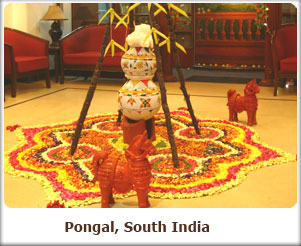 7. Pongal - All over South India: Pongal in Tamil means "boiling over or spill over." The boiling over of milk in the clay pot symbolizes material abundance for the household. Thai Pongal, celebrated at harvest time, is traditionally intended to thank the Sun God and farmstead livestock that helped create the material abundance.
7. Pongal - All over South India: Pongal in Tamil means "boiling over or spill over." The boiling over of milk in the clay pot symbolizes material abundance for the household. Thai Pongal, celebrated at harvest time, is traditionally intended to thank the Sun God and farmstead livestock that helped create the material abundance.
8. International Kite Festival - Ahmedabad, Gujarat State: International Kite Festival is held at Ahmadabad on January 14 every year, to coincide with the festival of Uttarayan or Makar Sankranti. The festival of Uttarayan is a uniquely Gujarati phenomenon, when the skies over most cities of the state fill with kites from before dawn until well after dark. The festival marks the days in the Hindu calendar when winter begins turning to summer, known as Makar Sankranti or Uttarayan. On what is usually a bright warm sunny day with brisk breezes to lift the kites aloft, across the state almost all normal activity is shut down and everyone takes to the rooftops and roadways to fly kites and compete with their neighbors.
9. Pattadakkal Dance Festival - Pattadakkal, Karnataka State: The Pattadakal dance festival is held every year during the month of January. Famous dancers from all over India come here to participate in this festival. It provides a musical treat to all admirers of dance and music and is a must visit if you like Indian classical dance and music. The event is organized by the Government of Karnataka and attracts many spectators as well as performers. Another added attraction at Pattadakkal dance festival is the crafts Mela that is organized for various craftsmen to showcase their works of art.
10. Modhera Dance Festival - Modhera Sun Temple, Gujarat: The Sun Temple at Modhera is positioned in such a manner that the sun's first rays illuminate the deity in the innermost sanctum through the main entrance. The incredibly beautiful Sun Temple acts as the backdrop during the romantic fete of classical dance. The beautiful Sun Temple acts as the backdrop during the festival of Indian classical dances held every year in January for three days. The Tourism Corporation of Gujarat organizes this annual festival of dance. The idea is to present classical dance forms in an atmosphere they were originally presented in.
11. Republic Day Parade - New Delhi: Republic Day, celebrated on January 26th every year, is one of India’s most important national events. It was on January 26th, 1950 that the constitution of India came into force and India became a truly Sovereign, Democratic and Republic state.
On this day -India finally enjoyed the freedom of spirit, rule of law and fundamental principle of governance. The patriotic fervor of the Indian people on this day brings the whole country together even in her embedded diversity
FEBRUARY
 1. Suraj kund Crafts Mela - Suraj kund, Haryana: The Suraj kund Crafts Mela is organized annually by the Haryana Tourism Department in the month of February. This delightful handloom and handicrafts fair is planned every year to promote the traditional Indian Handicrafts in rural ambience at Suraj kund in the vicinity of New Delhi. The fair was first time organized in 1981 and since then the fair continues to be a strong platform for Indian artists and craftsmen to display their skilled crafts and art work.
1. Suraj kund Crafts Mela - Suraj kund, Haryana: The Suraj kund Crafts Mela is organized annually by the Haryana Tourism Department in the month of February. This delightful handloom and handicrafts fair is planned every year to promote the traditional Indian Handicrafts in rural ambience at Suraj kund in the vicinity of New Delhi. The fair was first time organized in 1981 and since then the fair continues to be a strong platform for Indian artists and craftsmen to display their skilled crafts and art work.
The fair is not only limited to exhibitions of artwork but also presents the visual delight to its visitors in the form of special Natyashala folk dances and musical evenings at the open-air theatre. These programs are also accompanied by lip smacking and delicious rural cuisine, adding colors to this popular crafts fair.
2. Goa Carnival: February heralds the carnival at Goa. For three days and nights the streets come alive with colour. Held in mid February the weeklong event is a time for lively processions, floats, the strumming of guitars, graceful dances and of non-stop festivity. One of the more famous of the Indian Carnivals the Goa Festival is a complete sell out in terms of tourism capacities.
The carnival is meant to be a feasting-drinking-merrymaking orgy just before the austere 40 days of Lent. Huge parades are organized throughout the state with bands, dances and floats out all night on the streets, and grand balls held in the evenings. The carnival concludes with the famous red-and-black dance held by the Club National in Panajim on the final day.
3. Valentines Day – Goa: Valentines Day is celebrated throughout the world as a day of love and bonding. What originated in the west has taken the youth of perhaps from all nooks of the world in its arena. St. Valentine stands as a mascot of unified love for the people who believe in celebrating this day. India being a country of different religions and castes, has also accepted this day as one of its own. A country that celebrates almost all the festivals of the world is not alien to this day of love. As the world remembers St. Valentines, India has its reasons to remember the Hindu lord of love, Kamdev. Lord Kamdev is a part of the Hindu myths and possesses a flowery bow. A belief in India says that the arrow that leaves his bow often strikes the lovers. The importance of Valentines Day in India grows every year. India being the land where the treatise of love took birth is now a part, as the world celebrates Valentines.
4. Mahashivratri - All over India especially North and West India: The festival of Mahashivratri (literally means the 'Grand Night dedicated for the worship of Lord Shiva'). is looked upon with greatest reverence & respect by the devotees of Lord Shiva. This festival is celebrated every year on the 13/14th day in the Krishna Paksha (waning moon fortnight, just before the new moon) of the month of Phalgun. As per the English calendar this is somewhere around Feb or March.
This day and more so the night is dedicated by the devotees of Lord Shiva for his worship, practice of various austerities & meditation. All the Shiva Temples are fully decorated and there are hordes of devotees queuing up to get Darshan of Lord & offer their obeisance's at the feet of Lord Shiva on this special day.
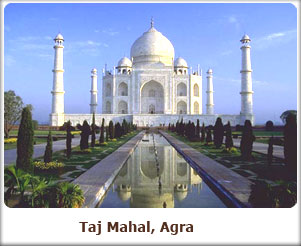 5. Taj Mahotsav – Agra: The Taj Mahotsav is a non-stop 10 day carnival held annually at Shilpgram, near Taj Mahal. The impressive festival commences with a spectacular procession inspired by Mughal splendor. Bedecked elephants and camels, drum beaters, folk artists and master craftsmen together recreate the glorious past of the Mughals.
5. Taj Mahotsav – Agra: The Taj Mahotsav is a non-stop 10 day carnival held annually at Shilpgram, near Taj Mahal. The impressive festival commences with a spectacular procession inspired by Mughal splendor. Bedecked elephants and camels, drum beaters, folk artists and master craftsmen together recreate the glorious past of the Mughals.
The Taj Mahal Mahotsav area becomes a live culture, crafts and traditions. It is a great opportunity for legendary artisans to display their exquisite works of art. Marble of course rules the festivities each year for obvious reasons.
6. Konark Festival - Konark Temple, Orissa State: Konark Dance Festival takes place in an open-air auditorium against the backdrop of the floodlit temples that reverberates with the beats of 'Raga' and 'Tala' to fill the air with the sounds of classical music. The classical extravaganza is a journey through eternal ecstasy.
The festival provides a platform for both to the performing artiste and the dance connoisseurs in appreciating the essence of various classical dance forms of the country and also to the new artists who are yet to make their mark on the international scale.
7. Deccan Festival - Hyderabad, Andhra Pradesh State: Every year gracious Hyderabad comes alive during the Deccan Festival. There are cultural programmes with ghazal nights, qawalis and mushairas, typical of the city. A pearl and bangle fair displays creations in lustrous pearls and multi-hued bangles that are local specialties. A food fest serves the best of Hyderabad's famed cuisine to visitors.
8. Nagaur Cattle Fair - Nagaur, Rajasthan: Nagaur Cattle Fairor pashu mela at Nagaur is very popular fair in all over the Rajasthan. It is the 2nd largest animal fair of India. Nagaur Cattle Fair held in the month of January-February. It is the traditional and cultural fair of Nagpur, Rajasthan.
Thousands of animals are gathered at the cattle fair for trading. Traders come to buy and sell cows, bullocks, oxen and camels. Various games are organized by organization during this four day festival as night function, many artist programme and folk dance music. People decoratedtheir animal with beautiful designs and Royal clothes. This festival is most interesting fact is animal race, camel races, cock fights etc.
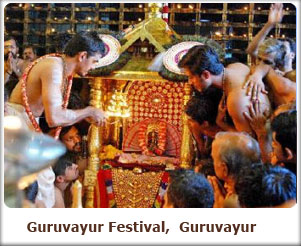 9. Guruvayur Festival - Guruvayur, Kerala State: Guruvayur Festival is celebrated with much pomp and zeal in Guruvayur temple in Kerala. It is a festival celebrated by the Hindus. Some of the festivals celebrated at Guruvayur temple are Vishu, Ashtami Rohini, Mandalam, Ekadasi, Ashtami Rohini, Kuchela's Day, Chembai music festival and Narayaneeyam day. Ulsavam is the main festival of Guruvayur temple. Ulsavam takes place in the month of February and March and is a 10 day long festival. The festival begins with the hoisting of the flag on Dwajastambham and an elephant race. Pilgrims can witness the procession of the elephants throughout six continuous days. Various cultural programs are also held during this time. Oblations are offered on the 8th day to the Lord’s lieutenants during Utsavabali. It symbolizes the destruction of desire and anger from our lives. Many devotees take a dip in the temple pond to wash off their sins. The Lord after 11 days returns to his holy place and the flag is also lowered at the end of the festival.
9. Guruvayur Festival - Guruvayur, Kerala State: Guruvayur Festival is celebrated with much pomp and zeal in Guruvayur temple in Kerala. It is a festival celebrated by the Hindus. Some of the festivals celebrated at Guruvayur temple are Vishu, Ashtami Rohini, Mandalam, Ekadasi, Ashtami Rohini, Kuchela's Day, Chembai music festival and Narayaneeyam day. Ulsavam is the main festival of Guruvayur temple. Ulsavam takes place in the month of February and March and is a 10 day long festival. The festival begins with the hoisting of the flag on Dwajastambham and an elephant race. Pilgrims can witness the procession of the elephants throughout six continuous days. Various cultural programs are also held during this time. Oblations are offered on the 8th day to the Lord’s lieutenants during Utsavabali. It symbolizes the destruction of desire and anger from our lives. Many devotees take a dip in the temple pond to wash off their sins. The Lord after 11 days returns to his holy place and the flag is also lowered at the end of the festival.
10. Desert Festival – Jaisalmer: The Desert Festival exudes the delightful spirit of this desert land. Fort three days, the otherwise barren land of Jaisalmer comes to life and is clustered with hordes of colorfully dressed people. Some cherished moments of the glorious and illustrious past and a rich culture are on display. The traditional dancers and the audience seem to be on a euphoric trip. The Turban Tying competition and Mr. Desert contest add a touch of excitement to the celebration. The traditional Gair dancers leave the crowds enchanted by their thrilling performance.
MARCH
1. Khajuraho Dance Festival: Once the religious capital of Chandela dynasty, one of the powerful Rajput dynasties of Central India, Khajuraho is now famous for it's enchanting temples and it's legendary Khajuraho dance festival. The week- long festival of classical dances is held every year in February/March against the spectacular backdrop of the magnificently lit temples. Khajuraho Dance Festival is held every spring in the town of Khajuraho in order to celebrate the glory of the temples. It is believed that classical dance basically comes from the Hindu temples and attained it's maturity.
This Festival is a cultural festival for the celebration of the Indian arts- dance and music handling down from generation to generation. The Khajuraho Festival of Dances shows the best classical dancers and dances in the country. It is held during the month of March from 6th to 12th. Different classical dances are presented during this festival, like the -Kathak, Bharatnatayam, Kuchipudi, Odissi, Manipuri etc.
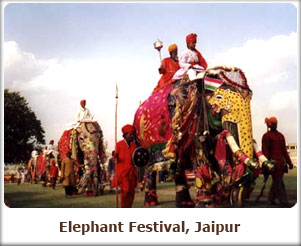 2. Elephant Festival - Jaipur, Rajasthan State: Out of several festivals celebrated with elephants, the one which is widely participated by Indians and foreign tourists is the Elephant Festival celebrated in Jaipur on the day of Holi in Phalgun.
2. Elephant Festival - Jaipur, Rajasthan State: Out of several festivals celebrated with elephants, the one which is widely participated by Indians and foreign tourists is the Elephant Festival celebrated in Jaipur on the day of Holi in Phalgun.
This is an annual event held at Jaipur Chagan Stadium where people gather in large crowds to celebrate the occasion with much pump and gaiety. Jaipur Elephant Festival, perhaps the only festival where Elephants are given prime importance. Here, as you would expect from the name of the Festival – Elephants are the centre of attraction.
During the festival, Jaipur comes alive with elephants, dancers and musicians which draw visitors from all over the world. The elephants stride majestic-experience for everybody by parading their decorated trunks and tusks. And the most noticeable feature of this festival is that all the Elephants which take part in this festival are female Elephants.
3. Holi the festival of colours - All over India: One of the major festivals of India, Holi is celebrated with enthusiasm and gaiety on the full moon day in the month of Phalgun which is the month of March as per the Gregorian calendar.
Holi festival may be celebrated with various names and people of different states might be following different traditions. But, what makes Holi so unique and special is the spirit of it which remains the same throughout the country and even across the globe, wherever it is celebrated.
The most boisterous of Indian festivals, Holi is associated with Lord Krishna. Gay crowds fill the streets, squirting colored water on people regardless of age, caste or creed. Greetings and sweets are exchanged among friends and relatives.
4. International Yoga Week: Yoga literally means "union". It is a union of breath and the body, the mind and muscles and most importantly union of the self to the divine. What better place to become "united" than on the sacred banks of Mother Ganga, in a land to which sages have flocked for millennia? To promote the ancient science of Yoga, a weeklong event is organized by the State Tourism Department in Rishikesh (Himalayan Foothills) during the first week of February. Detailed lectures, demonstrations of various Asanas by prominent ![]() exponents of Yoga are the major highlights of the Yoga Week.
exponents of Yoga are the major highlights of the Yoga Week.
5. Mewar Festival: The Mewar Festival is celebrated to welcome the advent of spring. It coincides with the festival of Gangaur, and has a unique charm about it. The festival of Gangaur is very significant for women of Rajasthan. It is a time for them to dress up in their best clothes and participate in the festival.
They gather to dress the images of Isar and Gangaur and then carry them in a ceremonial procession through different parts of the city. The procession winds its way to the Gangaur Ghat at Lake Pichola. Here, the images are transferred to special boats amidst much singing and festivity.
6. Gangaur Festival: Lord Shiva and goddess Parvati are worshipped in this festival of Gangaur. This festival is specifically meant for women folks. The unmarried women worship Gauri for blessing them with good husband, while married women do so for the welfare, health and longevity of their husbands and cheerful married life.
It is believed that after a temporary long sacrament Gauri and Shiva reunited on this day. The small doll like Idols of the Shiva and Gauri are made of wood. These divine male and female entities are called ‘Isar’ and ‘Gangaur’.
The festival commences on Holi. The festival runs through many days. Young girls pray for grooms of their choice while married women seek a long life for their husbands. The ladies beautify their hands and feet by temporary decoration by drawing designs with Mehendi.
7. Mahavir Jayanti: On Mahavir Jayanthi, Jain temples are decorated with flags. In the morning the idol of Mahavira is given a ceremonial bath called the 'Abhishek'. It is then placed in a cradle and carried in a procession around the neighborhood. The devotees will make offerings of milk, rice, fruit, incense, lamps and water to the Tirthankara. Some sections of the community even participate in a grand procession. Lectures are held to preach the path of virtue. People meditate and offer prayers. Donations are collected to save the cows from slaughter. Pilgrims from all parts of the country visit the ancient Jain Temples at Girnar and Palitana in Gujarat on this day.
APRIL
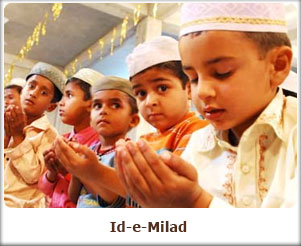 1. Id-e-Milad: Id-e-Milad is a festival of both rejoicing and mourning. The festival of Id-e-Milad popularly known as Barah Wafat the twelfth day is one of the important festival in the Muslim calendar. The day commemorates the birth and also the death anniversary of Prophet Mohammed. The word 'barah' signifies the twelve days of the Prophet's sickness. During these twelve days, priests and learned men deliver sermons and Koranic texts in mosques, focusing on the life and noble deeds of the Prophet. In some parts of the country, a ceremony known as sandal rites performed over the symbolic footprints of the Prophet engraved in stone. It is considered auspicious to offer prayers and give alms on this day.
1. Id-e-Milad: Id-e-Milad is a festival of both rejoicing and mourning. The festival of Id-e-Milad popularly known as Barah Wafat the twelfth day is one of the important festival in the Muslim calendar. The day commemorates the birth and also the death anniversary of Prophet Mohammed. The word 'barah' signifies the twelve days of the Prophet's sickness. During these twelve days, priests and learned men deliver sermons and Koranic texts in mosques, focusing on the life and noble deeds of the Prophet. In some parts of the country, a ceremony known as sandal rites performed over the symbolic footprints of the Prophet engraved in stone. It is considered auspicious to offer prayers and give alms on this day.
2. Baisakhi - Harvest Festival, North India: Baisakhi is a seasonal festival with a special accent. It is celebrated all over the State on the first of Baisakh. This is the time when harvest is gathered in and the farmer exults in the fulfillment of his year's hard work. He joins the merry-making with full gusto and does not mind walking for miles to be able to do so. Since this fair is also an expression of prosperity, singing and dancing constitute its most enchanting features. The Punjab's famous Bhangra and Giddha are inextricably linked with this festival.
3. Tamil New Year: The month of Chitthirai i.e. from mid-April to mid-May is the first month of Tamil calendar. The month usually starts from 14th April, the day known as Tamil New Year. This is an auspicious occasion for Tamilians (people of Tamil origin) living all over the world. People exchange greetings by wishing “Puthandu Vazthukal” – Happy New Year, with great passion. According to Hindu Mythology, this is the day on which Lord Brahma (the creator of the universe) started the creation of the world.
4. Summer Festival - Major Hill Stations: The steep rocks, tranquil lakes, picturesque locations and the pleasant climate of Mount Abu make it an ideal location for the festival. The three-day festival is a feast of folk and classical music and a window to the tribal life and culture of Rajasthan. The festival begins with the singing of a ballad, which is followed by Gair, Ghoomar and Daph folk dances which enthral the spectators.
There are several beautiful hill stations in Tamil Nadu. With the Summer Festivals on, the hills are even hospitable to welcome the visitors coming from India and abroad. The summer festival is held in the 'Queen of Hill Stations' the evergreen Ooty, the exquisite Kodaikanal or the salubrious heights of Yercaud - where boat races, flower and fruit shows are specially organized.
Tourists also get a splendid opportunity to go trekking in any of Tamil Nadu's other hill stations that promise unforgettable holidays off the beaten track. Cultural programs, adventure sports, boat races, flower and fruit shows add to the splendor of the festival.
5. Kumbh Mela: Kumbh Mela is a mega event that is organized four times in every twelve years in India. The festivity has truly come into the limelight and acquired fame not just in India, but made its presence felt even abroad. The celebration of Kumbh Mela takes places at four different places, namely Prayag (Allahabad), Ujjain, Haridwar and Nasik. Maha Kumbh mela, also known as the great Kumbh mela, is held only once in twelve years in Allahabad.
Millions of devotees come from all across the country to witness this distinguished festivity. The credit for initiating the Kumbha Mela festivity can be attributed to the King Harshvardhana of Ujjain, who took it as an opportunity to make donations to help the poor and needy and to strengthen the faith of people of all religions in the divine power.
MAY
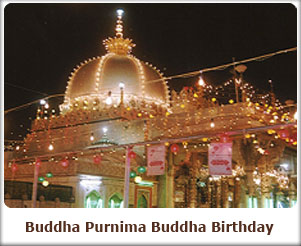 1. Buddha Purnima Buddha Birthday - All over India: Buddha Jayanti or also known as Buddha Purnima is the most sacred festivals of Buddhist. Buddha Purnima (Buddha Birthday) is celebrated in remembrance Lord Buddha. Lord Buddha is the founder of Buddhism. This day is the birth anniversary of Lord Buddha. It falls on the full moon of the fourth lunar month (month of Vaisakh) i.e. April or May.
1. Buddha Purnima Buddha Birthday - All over India: Buddha Jayanti or also known as Buddha Purnima is the most sacred festivals of Buddhist. Buddha Purnima (Buddha Birthday) is celebrated in remembrance Lord Buddha. Lord Buddha is the founder of Buddhism. This day is the birth anniversary of Lord Buddha. It falls on the full moon of the fourth lunar month (month of Vaisakh) i.e. April or May.
2. Urs (Ajmer, Rajasthan): The remains of Sufi saint Khwaja Moin-ud-din Chishti lie buried in 'Dargah Sharif' in Ajmer and are held in held in great reverence by devotees of all communities. The site has the distinction of holding the largest Muslim fair in India, where more than five lakh devotees from different communities come to pay homage to the Khwaja on his Urs (death anniversary). The pilgrims make rich offerings called 'nazrana' at the sacred spot where the saint has been entombed that include rose and jasmine flowers, sandalwood paste, perfumes and incense that put in to the fragrance that floats in the air inside the shrine. Cash offerings are also made. Also offered by devotees are the 'chaadar', 'ghilaph' and 'neema', which are votive offerings for the tomb. Outside the holy place of the Dargah, professional singers called 'qawwals' sit in groups and sing hymns in the praises of the saint in a characteristic high-pitched voice. One can also see 'fakirs' on the main gate begging for alms in the name of the Khwaja.
3. International Flower Festival (Gangtok, Sikkim): The International Flower Festival showcases an exceptional show of interesting varieties of flowers including rare orchids and rhododendrons. In this festival, you can also figure-out remarkable plants that are actually indigenous to Sikkim. This Flower Festival is celebrated in summers (April/May) during the peak blossoming season in Sikkim. During these months, the horticultural delights of Sikkim look their best. The venue is made near White Hall, not far from Gangtok, the capital of Sikkim. The festival is accompanied by food and entertainment in grand terms. The experts and masters of botanical sciences also come up to hold lectures and seminars. The International Flower Festival is definitely a colorful treat for the eyes and the event is important not only on state level but on the national level too. The amazing assortment of flowers confirms it as a fantastic event and attracts a multitude of people from all over.
JUNE
1. Hemis Festival - Hemis, Ladakh: The courtyard of Hemis Gompa-the biggest Buddhist monastery in Ladakh is the stage for the famous 'Hemis' festival that celebrates the birth anniversary of Guru Padmasambhava. The colourful two-day pageant falls on the 10th day (Tse-Chu) of the Tibetan lunar month. The local people are seen dressed up in their finest traditional garb for the occasion. Lamas called 'chhams' perform splendid masked dances and sacred plays to the accompaniment of cymbals, drums and long horns. The head lama presides over the function. The festival takes an auspicious turn every 12 years in the Tibetan Year of the Monkey, when the two-storey high 'Thanka' depicting Padmasambhava is displayed. This famous 'Thanka', richly embroidered with pearls and semi-precious stones, is due to be displayed at this year’s festival i.e. in 2004. A colourful fair, displaying some beautiful handicrafts, is the special highlight of the festival.
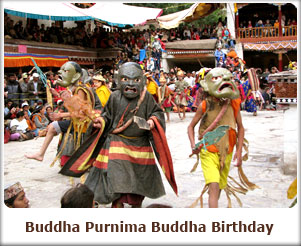 2. Sindhu Darshan Festival - Leh, Ladakh: The Sindhu Darshan Festival, as the name suggests, is a celebration of River Sindhu, also known as the Indus. Last year, the Festival was organized from 6-8 June 2000 at Shey livened up by the presence of a wide variety of cultural troupes from various corners of India. Troupes from States where the mighty Rivers of India run, brought with them water from those rivers in earthen pots and immersed the pots in the Indus, thereby mingling the waters from all over India with that of the mighty 'Indus', the river that gave India its name.
2. Sindhu Darshan Festival - Leh, Ladakh: The Sindhu Darshan Festival, as the name suggests, is a celebration of River Sindhu, also known as the Indus. Last year, the Festival was organized from 6-8 June 2000 at Shey livened up by the presence of a wide variety of cultural troupes from various corners of India. Troupes from States where the mighty Rivers of India run, brought with them water from those rivers in earthen pots and immersed the pots in the Indus, thereby mingling the waters from all over India with that of the mighty 'Indus', the river that gave India its name.
3. Champakulam Boat Race - Alleppey, Kerala: Visit Alappuzha in the Malayalam month of Midhunam (June-July) and you can be a part of the world famous Champakulam Boat Race, which celebrates the arrival of Lord Krishna idol at the Ambalaphuza temple. What a colourful merriment does it portray! Prime Minister Jawaharlal Nehru was once invited for a boat ride from Kottayam to Alleppey. En route, Nehru saw a boat race on Alleppey's Punnamada Lake and got so enthralled that he jumped into the boat that won the race. Eventually, the Punnamada Boat Race became world famous as the Nehru Trophy Boat Race, which is held still today on the second week of August every year. The trophy is a replica of a snake-boat in silver, placed on wooden pedestal on which the following words of Panditji are engraved above his signature.
JULY
1. Mango Festival - New Delhi: The Mango Festival of New Delhi is organized by the Delhi Tourism and Transportation and Development Corporation in collaboration with the Agricultural and the Processed Food Products Export Authority, National Horticulture Board New Delhi Municipal Council. The two days of Delhi exhibits a wide variety of the mangoes that innumerable of visitors flock in to experience. See the wide varieties of the mangoes including the alphonso, the mallika, the amprapali, the himsagar, the malda, the balia and the chorasya. Taste the mouth watering dhoon, the fazia, the gelchia, the nigarin kheria, the ruchika and the shamsi. The names of the diversified varieties are as interesting as the lovely tastes. Being a part of this two day festivals is great experience in itself.
2. Amarnath Yatra—Hindu Pilgrimage to Holy cave – Kashmir: Shiva, in the form of a lingam, is formed naturally of an ice - stalagmite one of the holy trinity, Shiva is a living god. The most ancient and sacred book of India, the Rig Veda evokes his presence in its hymns. Vedic myths, ritual and even astronomy testify to his existence from the dawn of time.
Shiva is known to have made his home in the Himalayas. He built no house nor shelter, not for himself or his bride. He was an ascetic, and yet married; he could be both for "he was the wild god sporting in the forest or taking his ease on a cloud."
Legend has it that Shiva recounted to Parvati the secret of creation in the Amarnathji cave. Unknown to them, a pair of mating pigeons eavesdropped on this conversation and having learned the secret, are reborn again and again, and have made the cave their eternal abode. Many pilgrims report seeing the pigeons-pair when they trek the arduous route to pay obeisance before the ice-lingam (the phallic symbol of Shiva).
 3. Rath Yatra - Puri, Orissa State: Rath Yatra, which is also known as the Chariot Festival, is one of the most prominent festivals of Orissa, which is celebrated in the holy city of Puri. ‘Rath Yatra’ has derived its name from the words ‘Rath’, meaning ‘Chariot’, and ‘Yatra’, meaning ‘Procession’. This festival is celebrated with gusto in almost every part of the country. However, it was initiated in Jagannath Temple and it still attracts devotees from different parts of India. Jagannath Puri Rath Yatra is a very colorful festivity, in which people participate enthusiastically.
3. Rath Yatra - Puri, Orissa State: Rath Yatra, which is also known as the Chariot Festival, is one of the most prominent festivals of Orissa, which is celebrated in the holy city of Puri. ‘Rath Yatra’ has derived its name from the words ‘Rath’, meaning ‘Chariot’, and ‘Yatra’, meaning ‘Procession’. This festival is celebrated with gusto in almost every part of the country. However, it was initiated in Jagannath Temple and it still attracts devotees from different parts of India. Jagannath Puri Rath Yatra is a very colorful festivity, in which people participate enthusiastically.
AUGUST
1. Nehru Trophy Boat Race, Snake boat race, Alleppey, Kerala: Alappuzha is famous for its annual boat race, held on the second Saturday of August every year. The long elegant snake boats, with crews of over hundred men vying to win the coveted trophy, attract spectators from all over.
This was started in 1952 when India's first Prime Minister, Mr. Jawaharlal Nehru, visited Alappuzha, and inaugurated the function in which the gigantic snake boats with over 100 rowers in each raced one another. Having gone through the tremendous excitement of sailing in a snake boat popularly known as Chundan he donated a rolling trophy to be awarded to the winner of the Snake Boat Races to be held every year.
2. Independence Day, All over India: On 15 August 1947, India attained freedom from the British Rule. Every year, August 15 is celebrated as the Independence Day in India. This national festival is celebrated with great enthusiasm all over the country.
The Independence Day of any country is a moment of pride and glory. On this special occasion, rich tributes are paid to the freedom fighters who sacrificed their lives and fought to free their motherland from the clutches of the oppressors - British who ruled the country.
3. Teej Festival - All over North India: A unique festival for women, Teej is primarily celebrated in Rajasthan, Punjab, Haryana, parts of Uttar Pradesh and Bihar. Teej festival is dedicated to the re-union of Goddess Parvati with Lord Shiva. Mostly celebrated among women, Teej festival is celebrated for longevity and well-being of husband and children.
Long swings decorated with flowers, colorfully dressed young girls and women, glittering jewellery, delicious feasts, tough fasting, religious processions and songs & dance mark the gaiety of Teej festival.
Teej festival is celebrated with much enthusiasm. Falling on the onset of monsoon after a long season of oppressive heat, Teej festival in India is also known as 'Sawan Festival'.
4. Onam - Harvest festival of Kerala: Onam is the most important harvest festival of Kerala and is an attraction for thousands of people within and outside the state. Ranging from four days to ten days, all the activities during this season are centered around worshipping, music, dances, sports, boat races and good food. It is celebrated in the Malayalam month Chingam (ending of August and beginning of September). 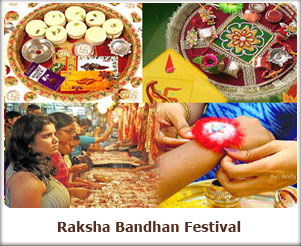 Onam is a harvest festival, and celebrates the bounty of nature after a year of hard labour. Elaborate procession of Trichur and spectacular snake boat races on River Pampa mark the merry-making nature of the festival. Women dress up in new saris and heavy jewellery and make elaborate and intricate designs of 'rangolis' (with coloured rice paste) and 'pookkalam' (with flowers) in front of their homes.
Onam is a harvest festival, and celebrates the bounty of nature after a year of hard labour. Elaborate procession of Trichur and spectacular snake boat races on River Pampa mark the merry-making nature of the festival. Women dress up in new saris and heavy jewellery and make elaborate and intricate designs of 'rangolis' (with coloured rice paste) and 'pookkalam' (with flowers) in front of their homes.
5. Raksha Bandhan- The Thread of Love festival: Rakshabandhan or Rakhi which is celebrated on a full moon day in the month of Sravan (August) is a day when brothers and sisters reaffirm their bonds of affection. It is usually a festival of the Hindus though today people from different religions participate as well.
Sisters tie colourful threads or rakhis on their brother's wrists. The brothers in turn promise to protect their sisters and give them gifts.
SEPTEMBER
1. Janmashtami - Birthday of Lord Krishna, North India: Eight days after the full moon of Shravan, falls the festival of Janmashtami, the birthday of Lord Krishna. Krishna Janmashtami is an important festival in the Hindu calendar. The first day is Krishnashtami or Gokulashtami. The second day is called Kalastami or more popularly Janmashtami. It is celebrated with great devotion throughout the country. Vrindhavan, Mathura, Dwaraka are the most popular Krishna temples as it is believed that Lord Krishna lived here. In all these locations, janmashtami is celebrated with lot of splendor. The image of the infant Bala Krishna is bathed and is cradled in the midnight time. The conch shell is blown and the devotees celebrate the birth of the Protector of the world by singing devotional songs and by dancing with great joy.
2. Ganesh Chaturthi - Birthday of Lord Ganesha: Ganesh Chaturthi is celebrated on the 4th day of the bright half of Bhadrapad. This festival marks the birthday of Lord Ganesh. Lord Ganesha or Ganpati is one of the most popular deities in the Hindu religion. It is worshipped by both Shaivites and Vaishnavites. Even Buddhists and Jains have faith for Ganpati. He is considered to be an avatar of both Shiva and Vishnu.
3. Brahmotsavam - Tirupati, Andhra Pradesh State: Tirumala Brahmotsavam is a Hindu festival celebrated annually at Tirumala Venkateswara Temple at Tirupati in Andhra Pradesh. The festival continues for 9 days in the months of September and October.
It is believed that Lord Brahma was the first to start this festival. He worshiped Sri Balaji on the banks of the Pushkarini in Tirupati to thank him for the protection of mankind. Hence the festival bears his name ‘Brahmotsavam’ which means Brahma’s Utsav.
In the Brahmotsav celebrations, the powerful snake transforms itself as the vehicle for god. The moral behind the prayers that are offered during Garodtsav, is to pray to God for a living with high values and morals.
OCTOBER
1. Gandhi Jayanti - Mahatma Gandhi Birthday: Gandhi Jayanti celebrates the birth anniversary of Mahatma Gandhi popularly known as the Father of the Nation. Born on the 2nd of October 1869 at Porbandar in Gujarat. He is known for his invaluable contribution in India's freedom struggle. His principles of truth, non-violence and honesty are still remembered today. Mahatma Gandhi was an intensely active personality. He was interested in everything that concerns the individual or society. He is best known as the matchless political leader who evolved the new technique of "satyagraha". His fight against untouchability and the notions of superiority and inferiority by birth are also fairly well known.
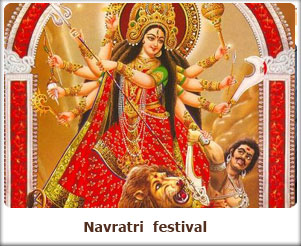 2. Navratri - Goddess Durga prayer festival week, North India: 'Nav' means 'nine' and 'ratri' means 'night', thus, 'Navratri' means 'nine nights'. There are many legends attached to the conception of Navratri like all Indian festivals but all of them are related to Goddess Shakti (Hindu Mother Goddess) and her various forms. Though it is one of the most celebrated festivals of Hindu calendar, it holds special significance for Gujratis and Bengalis and one can see it in the zeal and fervor of the people with which they indulge in the festive activities of the season. The first three days of Navratri are dedicated to Goddess Durga (Warrior Goddess) dressed in red and mounted on a lion, next three to Goddess Lakshmi (Goddess of Wealth and Prosperity) dressed in gold and mounted on an owl and finally, last three to Goddess Saraswati (Goddess Of Knowledge) dressed in milky white and mounted on a pure white swan.
2. Navratri - Goddess Durga prayer festival week, North India: 'Nav' means 'nine' and 'ratri' means 'night', thus, 'Navratri' means 'nine nights'. There are many legends attached to the conception of Navratri like all Indian festivals but all of them are related to Goddess Shakti (Hindu Mother Goddess) and her various forms. Though it is one of the most celebrated festivals of Hindu calendar, it holds special significance for Gujratis and Bengalis and one can see it in the zeal and fervor of the people with which they indulge in the festive activities of the season. The first three days of Navratri are dedicated to Goddess Durga (Warrior Goddess) dressed in red and mounted on a lion, next three to Goddess Lakshmi (Goddess of Wealth and Prosperity) dressed in gold and mounted on an owl and finally, last three to Goddess Saraswati (Goddess Of Knowledge) dressed in milky white and mounted on a pure white swan.
Dandiya and Garba Rass are the highlights of the festival in Gujarat while farmer sow seeds and thank the Goddess for her blessings and pray for better yield. In olden times, this festival was associated with the fertility of Mother Earth who feed us as her children. Sweetmeats are prepared for the celebrations and children and adults dress up in new bright-colored dresses for the night performances. With commercialization, the festival has moved on to be a social festival rather than a religious or agrarian festival. In some communities people undergo rigorous fasts during this season that lasts for the nine days of the festival, only to be opened on the tenth day of Dussehra. However, nothing dampens the spirit of the devout followers of Mother Goddess as they sing devotional songs and indulge in the gaieties of the season.
3. Id-ul-Fitr (Ramzan) - All over India: Eid ul Fitr, also known as Choti Id, is celebrated by different names in different Muslim nations. It is called Idul Fitri in Indonesia, Shemai Eid in Bangladesh, Hari Raya Puasa or Hari Lebaran in Malaysia and Ramazan Bayrami in Turkey. It marks the end of the fasting month of Ramadan. While, it is celebrated in varied ways in different countries, some rituals are common in the entire Muslim community across the world. The festival is celebrated with great enthusiasm and fervor everywhere in consonance with its sheer spirit and significance for the Muslims. The article gives an insight into the traditions and customs observed on this pious day.
4. Durga Puja - Culmination of Durga festival, North India & West Bengal: Durga Puja is an important Hindu Festival celebrated all over India with different rituals and festivities especially in eastern India. It is celebrated in the month of September/October every year. Durga Puja is one of the most important festivals in India. Durga Puja is more than a festival. It is a celebration of life, culture, popular customs and traditions. It is a time of reunion and rejuvenation to love, to share and to care.
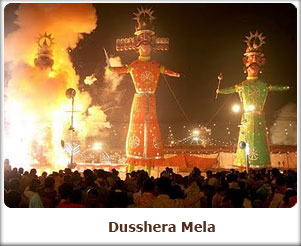 5. Dusshera Mela - All over India: Dussehra is a very important festival of the Hindus celebrated all over India especially in North India with loads of fun and zest. On the 10th day of Ashwin, when people celebrate Dussehra, colossal effigies of Ravana are burned in several places to mark the victory of Ram. Along with Ravana, effigies of his brother Kumbhkarna and son Meghnad are also burned marking an end of all evils.
5. Dusshera Mela - All over India: Dussehra is a very important festival of the Hindus celebrated all over India especially in North India with loads of fun and zest. On the 10th day of Ashwin, when people celebrate Dussehra, colossal effigies of Ravana are burned in several places to mark the victory of Ram. Along with Ravana, effigies of his brother Kumbhkarna and son Meghnad are also burned marking an end of all evils.
People dress up as Ram and Lakshman and shoot arrows of fire at these effigies which are loaded with explosives symbolizing the victory of good over evil.
6. Fair in Kota, Rajasthan: The Dussehra fair in Kota, is a huge celebration that not only includes the ceremonial burning of effigies, but, additionally a number of cultural programs and processions are organized. Eminent and popular artists from all over the country are invited to participate in the cultural programs.
The concept of Processions on Dussehra is age old in Kota and over the years it has developed as a major attraction for tourists coming from all over the world and people from India. This fair is a good opportunity for traders to sell and exhibit their products for buyers both rural and urban. As against other places where this fair lasts for a day, in Kota it is one of the biggest fairs lasting for about a fortnight.
7. Rajgir Dance Festival - Rajgir, Bihar (Buddhist sector): Rajgir, the ancient capital of the Magadhan Empire in Bihar is held sacred by both Buddhists and Jains for its association with the Buddha and Mahavir. Department of Tourism, Bihar holds a colourful festival of dance and music, Rajgir Mahotsav or Dance Festival every year in Rajgir. Be it instrumental music, devotional songs, opera, folk dance, ballet or the many schools of classical dance and music, geniuses in their own realms of accomplishments, create an almost ethereal atmosphere. This festival held during last week of October attracts tourists in large numbers.
NOVEMBER
1. Sonepur Mela - Sonepur, Bihar: The famed cattle fair is held at Sonepur, in Northern Bihar on the banks of the River Ganga. It is one Of the Asia's largest cattle fair. The full moon day of the month of Kartik (November) is regarded as one of the most auspicious days for the Hindus.
The sprawling mela ground here with the pulsating market has the widest possible range of cattle and commodities. The array of shops sells all sorts of merchandise. Sonepur Fair is the only one of its kind where a large number of elephants are sold.
These are purchased mainly by forest departments and people involved with logging operations. Apart from elephants, a large number of cattle and horses are also brought to the fair for sale. Various folk shows, games and jugglers can be seen in the fair.
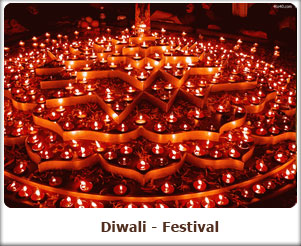 2. Diwali - Festival of Lights, All over India: One of the biggest festivals of Hindus, Deepawali or Diwali in India is celebrated with lots of enthusiasm and happiness. This festival is celebrated for five continuous days, with the third day being celebrated as the main Diwali or as 'Festival of Lights'. Fireworks are always associated with this festival. The day is celebrated with people lighting diyas, candles all around their house. Lakshmi Puja is performed in the evening to seek divine blessings of Goddess of Wealth. Diwali gifts are exchanged among all near and dear ones.
2. Diwali - Festival of Lights, All over India: One of the biggest festivals of Hindus, Deepawali or Diwali in India is celebrated with lots of enthusiasm and happiness. This festival is celebrated for five continuous days, with the third day being celebrated as the main Diwali or as 'Festival of Lights'. Fireworks are always associated with this festival. The day is celebrated with people lighting diyas, candles all around their house. Lakshmi Puja is performed in the evening to seek divine blessings of Goddess of Wealth. Diwali gifts are exchanged among all near and dear ones.
3. Ganga Mahotsav, Varanasi, Uttar Pradesh State: The Ganga Mahotsav is a classical music and dance fest organized in the enchanting backdrop of the religious town of Varanasi and river Ganges. This five-day festival coincides with the sublimely fantastic Dev Deepavali (festival of lights) celebrated with aplomb at Varanasi. The festival has been named Ganga Mahotsav out of respect and devotion for the River Ganges (Ganga) which has been for centuries the lifeline of the people and civilization living on its banks. The festival provides music and dance lovers with an opportunity to enjoy spirited performances from celebrated artistes.
The Ghats of Varanasi and banks of Ganges come alive and a bright on the occasion of the Kartik Purnima with thousands of diyas (earthen lamps) lit together. This spectacular event is celebrated as a tribute to the great river Ganges and is called the Dev Deepavali. A festival with great fanfare and feasts, Dev Depavali is celebrated on the full moon day of the month of Karthik (also known as Kartik Purnima). It is believed that gods descend on earth on Kartik Purnima. During the festival pilgrims throng the banks of Ganges and local people decorate the entire riverbank with tiny earthern lamps to welcome the gods. The shimmer and flicker of the tiny lamps are elegant and eye candy. The reverent multitude also chants the hymns while the priests hold forth huge and bright lamps.
4. Pushkar Cattle Fair - Pushkar, Rajasthan: Pushkar, the holy town in Rajasthan is known for it's sacred lake and the only Brahma Temple in the world. Legend has it that this lake was formed where Lord Brahma - the lord of creation - dropped a lotus on the day of the full moon. Every November, the famous Pushkar Fair is held for 7 days, starts on Noami, and finish on Kartik Poornima (Full Moon). The Fair is predominantly a gathering with thousands of camels, cattle and horses for trade, with added attractions of games, races, local folk dances, song and entertainment.
The tourist village is self sufficient and is specially designed to complement the natural beauty of the site. The village is arranged in blocks of tents, each with its own identity, being named after the famous dances of Rajasthan.
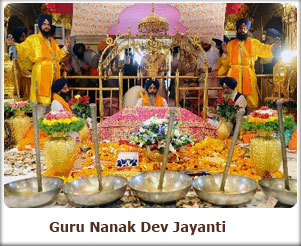 5. Guru Nanak Dev Jayanti, First Sikh Guru Birthday, All over India: Guru Nanak Dev, the founder of the Sikh faith was born in 1469 A.D. in the village of Talwandi in Lahore, Pakistan. Guru Nanak Dev Jayanti marks the birth anniversary of the founder of the Sikh religion. Sikhs do not worship idols and believe that God is formless. They celebrate the birth anniversaries of 10 Sikh gurus as Gurupurabs with devotion and dedication.
5. Guru Nanak Dev Jayanti, First Sikh Guru Birthday, All over India: Guru Nanak Dev, the founder of the Sikh faith was born in 1469 A.D. in the village of Talwandi in Lahore, Pakistan. Guru Nanak Dev Jayanti marks the birth anniversary of the founder of the Sikh religion. Sikhs do not worship idols and believe that God is formless. They celebrate the birth anniversaries of 10 Sikh gurus as Gurupurabs with devotion and dedication.
6. Lucknow Festival, Lucknow, Uttar Pradesh State: The Lucknow Mahotsav or Lucknow festival celebrates the Lucknow's living culture, which provides an insight into the old, cultured, atmosphere of the city. Colorful processions, traditional dramas, Kathak dances in the style of the famous Lucknow Gharana, Sarangi and sitar recitals along with ghazals, qawalis and thumri create a festive atmosphere. Exciting events like ekka races, kite flying, cock fighting and other traditional village games recreate an atmosphere of bygone Nawabi days. There is display of crafts and one can also have a taste of the famous mouth watering Nawabi cuisine.
The 15-day festival, organized jointly by UP Tourism and Lucknow District Administration have stalls by the craftsmen of other states presenting a composite culture of the entire country and provides a platform for the local talents of UP.
The Lucknow Festival captures the undying elegance and splendor of Awadh, now Lucknow. A brilliant showcase of the arts, crafts, and above all the exotic cuisine of this land, the festival is an once-in-a-lifetime experience. One can taste the traditional delicacies of Lakhnawi cuisine, ranging from mouth-watering vegetarian cuisine to the lip-smacking non-vegetarian spread for which Lucknow is famous.
7. Ellora Festival - Ellora, Aurangabad: Ellora caves are one of the most famous tourist attractions of Maharashtra. They are a representative of different faiths that have been experimented over here. Right from the Buddhists and the Hindus to the Jains, these caves tell a fascinating story about the evolution of each culture. As a token of respect for the rich legacy that thrives in these caves, the Ellora Festival is celebrated here, every year in March. This festival is dedicated to the growth of fine arts in India.
It is organized every year by Maharashtra Tourism Development Corporation (MTDC). Ellora festival showcases a plethora of talents in music and dance. Renowned artists, who have brought laurels to their fields, perform here during the festival. With the mystical caves forming the backdrop of this cultural bonanza, it makes the entire event all the more enjoyable and enchanting. One can enjoy the melodious music and savor the beautiful dances that portray different cultures of the country that regales in fine arts.
You will be amazed to see the various people who come here to portray their talents. Right from small children to trained singers, all of them put up brilliant performances that never fail to arouse loud and thunderous applauses from the audience. The dances and the music will give you a glance of how rich the different regions of India are in fine arts. Each region boasts of a unique dance or form of music, which is exclusive to that particular region and cannot possibly be found anywhere else. The one place where they all come and unite on a common platform and enthrall onlookers is during the Ellora Festival.
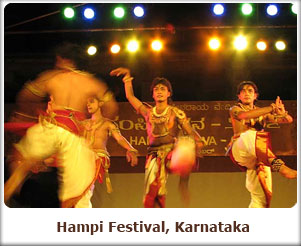 8. Hampi Festival - Vijayanagara Empire, Karnataka: Hampi exists as one of the International tourist spots in world Heritage. The hampi Utsav or Hampi Festival or Vijaya Utsav is a cultural extravaganza that has been celebrated since he times of the Vijayanagar reign. Hampi, Karnataka once the capital of the Vijayanagar Empire (One of the greatest empires in the history of India), comes alive during the lively festival of dance and music, held in the first week of November.
8. Hampi Festival - Vijayanagara Empire, Karnataka: Hampi exists as one of the International tourist spots in world Heritage. The hampi Utsav or Hampi Festival or Vijaya Utsav is a cultural extravaganza that has been celebrated since he times of the Vijayanagar reign. Hampi, Karnataka once the capital of the Vijayanagar Empire (One of the greatest empires in the history of India), comes alive during the lively festival of dance and music, held in the first week of November.
Hampi Festival is a three day event which generally commemorated from 3rd to 5th November. Hampi has always bestowed many surprises and eye catching events for all its tourists from time immemorial.
DECEMBER
1. Chennai Dance Festival, Chennai - Classical dances through a month: Chennai music and dance festival is a celebration of classical music and dance of South India held during mid December to mid January in the capital city of Chennai. The festival is held at a number of venues around the city by various 'sabhas' or organizations. Besides the auditoriums, well-known temple premises and heritage bungalows are being used as venues. The month long dance and music extravaganza will have performances of famous artistes from various parts of India.
2. Christmas, All over India: festival of Christmas celebrates the birth of Jesus Christ and conveys his message of love, tolerance and brotherhood. It's a celebration of humanity and mankind. Though Christmas is a primary festival of the Christian calendar but still it has a special significance in everyone's life. It is celebrated as a universal festival through out the nation. The first mention of 25th December as the birth date of Jesus occurred in 336 A.D. in an early Roman calendar. That day onwards this date is celebrated as the birth date of Jesus. In India this festival has a special significance since India is known for its unity in diversity worldwide. The celebration of Christmas shows that even people from different religion takes part in Christmas celebration just as the Indian Christians do.
Christians in India decorate banana or mango trees. They also light small oil-burning lamps as Christmas decorations and fill their churches with red flowers. They give presents to family members and baksheesh, or charity, to the poor people. In India, the poinsettia is in flower and so the churches are decorated with this brilliant bloom for the Christmas Midnight Mass. In South India, Christians put small clay lamps on the rooftops and walls of their houses at Christmas, just as the Hindus do during their festival called Diwali.
3. Mamallapuram Festival – Mahabalipuram: This event witnesses performances on the Indian classical dances such as the Bharat Natyam, Kuchipudi, Kathak, Mohiniattam, Odissi and Kathakali. The prominent people from their respected fields gather for this cultural event that is also promoted by the Tamil Nadu Tourism Department as one of the major cultural attraction to these parts of India. This four week Mamallapuram Dance Festival is held at the venue of Arjuna's penance, a bass-relief sculpted on the face of two enormous adjacent rocks, in Mamallapuram. The magnificent backdrop that is provided by the Pallava Rock Sculptures provides an aesthetic touch to this cultural dance festival.
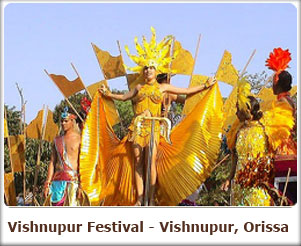 4. Vishnupur Festival - Vishnupur, Orissa: Vishnupur festival is the main occasion which attracts huge conglomeration of crowd from different places to experience the true legacy of Bankura, Bengal. The place is distinguished for its crafts, attractive terracotta temples and graceful silk saris.
4. Vishnupur Festival - Vishnupur, Orissa: Vishnupur festival is the main occasion which attracts huge conglomeration of crowd from different places to experience the true legacy of Bankura, Bengal. The place is distinguished for its crafts, attractive terracotta temples and graceful silk saris.
The Vishnupur festival is the perfect blend of past and the present traditions and is characterized by exhibition and sale of local handicrafts, sculptures, hand woven and printed cloths.
Another attraction of the festival is the stupefying performance of the rich musical tradition by musicians and singers of Vishnupur Gharana which further enriches the festival and makes it an important tourism attraction.
5. Kurukshetra Festival, Haryana: The festival in Kurukshetra, Haryana coincides with the Gita Jayanti, signifying the birth of the Srimad Bhagavad Gita. A visit to Kurukshetra during the festival is an exhilarating and spiritual experience. Pilgrims gather to take a dip in the sacred tanks of Brahma Sarovar and Sannehit Sarovar. Week -long Bhagwad katha (presenting stories in Bhagwad Gita, sacred book of the Hindus), Shloka recital, dance, dramas and 'deep daan' at Brahma Sarovar are part of the religious festivities. Free medical camps, book exhibitions and 'bhajan' recitals in classical tradition are organized.
6. Island Tourism Festival, Andaman & Nicobar Islands: Island Tourism Festival is a fortnight long festival organized by the Andaman & Nicobar Administration every year (December - January) gives a festive look to the Islands. Govt. agencies and private entrepreneurs from the islands and Mainland India also attend the exhibition organized during the festival.
The exhibition highlights the developmental aspects of these islands. Cultural troupes and artistes of national and international fame are invited to perform during the festival apart from performances by the talents of these islands including tribals. Water sports competitions like Nicobari Hodi race are organized.
Other attractions are Magic show, Puppet show, Floating restaurant, Baby show, Dog show, Canoe Race, Scuba Diving etc. The festival projects the image of the islands as an eco-friendly tourist destination.

